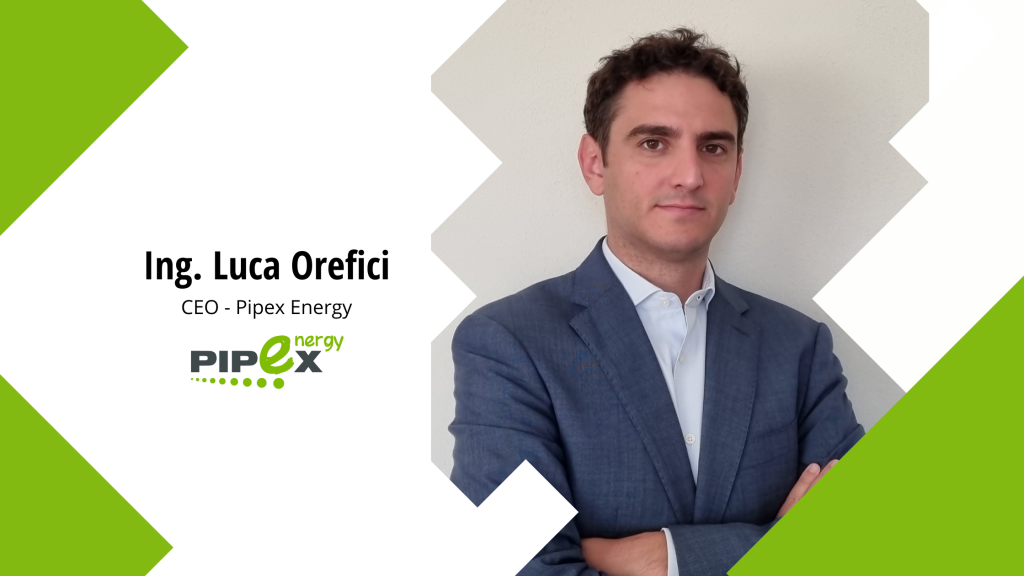Biocarbon: a precious resource for electric arc furnaces
A webinar dedicated to the theme of climate neutrality was held on 7th September in which our Green Manager, Ing. Luca Orefici, participated as a speaker. Furthermore, after the meeting, an interview was held which was subsequently published in the Scenarios / Experts’ corner section of the September issue of La Metallurgia Italiana.
Among the various topics discussed, we talked about the birth of Pipex Energy, a spin-off of Pipex Italia focused on the decarbonisation of industrial processes and technological innovation.
Below is the extract from the magazine La Metallurgia Italiana – International Journal of the Italian Association for Metallurgy.
We are facing a radical but needed transformation of our society. We must redesign every aspect of our life, including the production processes of the goods we consume, following environmental sustainability principles. And there is little time to do that.

With such consideration begins our interview with Mr. Luca Orefici, contacted by AIM further to his presentation during the webinar “The challenge of carbon neutrality. How to achieve and how much is it realistic to achieve the Carbon Neutrality?” held on September 7th.
Let’s start from the beginning, how was Pipex Energy born?
Pipex Energy born from the desire to contribute to a reconversion of our society focused on recognizing the limits of our planet and avoiding the climate crisis. In 2019 Pipex Italia, company whose Pipex Energy is a spin-off, started working with its parent company Železiarne Podbrezová to outline technological strategies and solutions related to the decarbonisation. At that time it was already clear that in the decades to come the dynamics of the market would have been inevitably connected to an ecological transition that could no longer be postponed. Transformation of which steel would have been part both as an indispensable material and as a good to be produced minimising the environmental impact. In 2021 we are moving in the groove traced by the European Green Deal, we see recovery plans from the pandemic focused on “green” subjects, and we are discussing with customers and suppliers about environmental certifications, product “carbon footprint” or “carbon scoring”. We thought it was then appropriate to create a company totally dedicated to the development of solutions to respond to such new context.
And, as can be seen from the conference of September 7, you started from biocarbon. Why?
In 2019 and throughout the 2020, together with our colleagues from production and our R&D center in Slovakia, we analysed the different options for the decarbonisation of our processes. The core business of Železiarne Podbrezová Group is the sales of seamless tubes, made from steel and billets produced by our own electric arc furnace (EAF) steel mill. If we look at our tube mills, it is evident that natural gas consumption is the central issue to be addressed, but moving to the steel mill it is the use of coal, or, more precisely, of anthracite, the problem to be solved. About half of our direct emissions in steel production are connected to the use of that element. And that is valid for every electric arc furnace. EAFs consume an average of 12 kg of coal per tonne of steel that, even if it sounds like a negligible value, account for the 40%-70% of the total direct emissions of the furnace. It is therefore evident that the first issue to be addressed in the context of a plan to reduce direct emissions is the replacement of that material. And biocarbon is the ideal candidate since it would be a source of biogenic and renewable carbon for steelmakers, neutral for what concern impacts on the climate. Obviously, in order for these conditions to be true, the supply of the biomass from which the biocarbon is obtained must follow sustainability criteria.
Let’s deepen the topic of biocarbon production and biomass sustainability.
Biocarbon can be obtained by pyrolysis or gasification. The first process involves heating the biomass in an oxygen-poor environment, while the second one is a partial oxidation process. In both cases, the obtained material is a carbon-rich solid. Pyrolysis is probably the most interesting option. Looking to this solution, the main variables of the process are the type of biomass and its characteristics, the maximum temperature of the treatment, the heating rate and residence time in the pyrolyzer. The degrees of freedom are therefore wide but the result will in any case be a solid product enriched in carbon and fixed carbon, with the simultaneous formation of a gaseous phase, called pyrolysis gas, which can find subsequent applications. About biomass, that has to be seen as a limited and precious resource. It is clear that we will not have enough biogenic material available to fully replace fossil fuels in their current applications. The exploitation of biomass should be strategically addressed to the valorisation of its chemical content rather than the energy content since it is the only source of renewable carbon we currently have. Such use must also be based on a sustainable supply chain. This implies that, for example, the supply is managed in order to ensure the real carbon neutrality of biocarbon, that the capacity of biomass to regenerate is not compromised, and that there is no impact on the food sector or a biodiversity loss.
Can you describe the potential applications of biocoal in electric arc furnaces?
The two main applications of fossil carbon in electric arc furnaces are the charge through the basket together with the scrap and the injection into the slag through a lance or perimeter injectors. The charge fulfils a dual function: it adds carbon to the metallic charge and supplies energy to process. The injection is instead aimed at foaming the slag, recovering at the same time metallic iron that would otherwise be lost leaving the furnace as an oxide. The possibility of using biocarbon to substitute fossil carbon for the above applications has been explored over the past 15 years. Because of the results obtained, we are confident that biocarbon can be used for the charge through the basket. The problem will be to optimize this substitution taking into account the main problems of the biocarbon, associated with its increased reactivity and lower mechanical durability if compared with fossil options. This will require further studies on the characteristics of the biocarbon and an optimization of the processes in the steel plant in order to make the most out of this material. If for the charge there is confidence that a solution will be found, for the injection there are still many doubts. In particular, it is believed that the low density of biocarbon and its limited reactivity toward the slag may complicate its use in electric arc furnaces. Pipex Energy will soon test a new solution, for which we have also filed a patent application, that involves the agglomeration of recycled polymers with biocarbon in order to solve the problems of biogenic material. The use of recycled plastic in electric arc furnaces is seen today with interest by many steelworks because, following the principles of circularity, a waste is recovered by giving it a second life in the form of steel. the possibility of combining a recycled material, the polymer, with a renewable material, the bio-carbon, in order to make the latter an effective foaming agent is the first activity in which Pipex Energy is engaged.
During the conference you mentioned integration opportunities between the production of biocarbon and the steel industry.
As I said earlier, when biocarbon is produced, pyrolysis gases are also generated. And these gases must be exploited because of energy reasons, because there is no point in wasting a renewable fuel, and because of economic reasons, linked to the minimization of biocarbon production costs. For example, pyrolysis gases can be converted into thermal power in order to make the pyrolysis process autothermal or to meet loads requiring high temperature heat. But such gases can also be converted into electricity, biofuels, chemicals or green hydrogen. The integration with metallurgical processes could allow, for example, to exploit the waste heat of our processes to dry the biomass and then use the pyrolysis gases to respond to the thermal loads of the different furnaces we have.
Can we ask a last overall comment about the decarbonisation of the steel industry?
I would like to start with a premise. We are living the decisive decade for the fight against climate change. Each political decision that will be taken has to consider on the one hand the possible economic and social impacts in the medium term and on the other hand that the consequences of inaction would be unsustainable in the long term. The challenge that we face today is mainly done for the sake of the generations to come. And the risks for who today is too young to provide any contribution or for those who have yet to be born, is such that personally I consider unacceptable the perspective to fail. The steel sector I had the chance to get in touch with during the last years has a deep understanding of how critical the situation is and is proving to be proactive in seeking for solutions. In many cases, particularly within the European context, the steel industry has always been devoted to efficiency improvements, to the reduction of pollutant emissions and to develop synergistic integration with local communities. But today the theme has become much more complex and an unprecedented degree of innovation will be required. This will inevitably involve costs that, hopefully, the market might be ready to share. However it is of primary importance that, looking at the EU, the institutions, both at the Union and at Member States level, will create the right framework to allow the steel industry to be active part if not even a driving force for the change, not a problem but a valuable ally.
Source: La Metallurgia Italiana – Intenational Journal of the Italian Association for Metallurgy
Article written by:

Marketing & Communication Department
Pipex Italia
For more information, details or requests, don’t hesitate to contact us at marketing@pipex.it.
Don’t miss out on our news and initiatives, read our BLOG and subscribe to our Newsletter

 infopipex@pipex.it
infopipex@pipex.it
